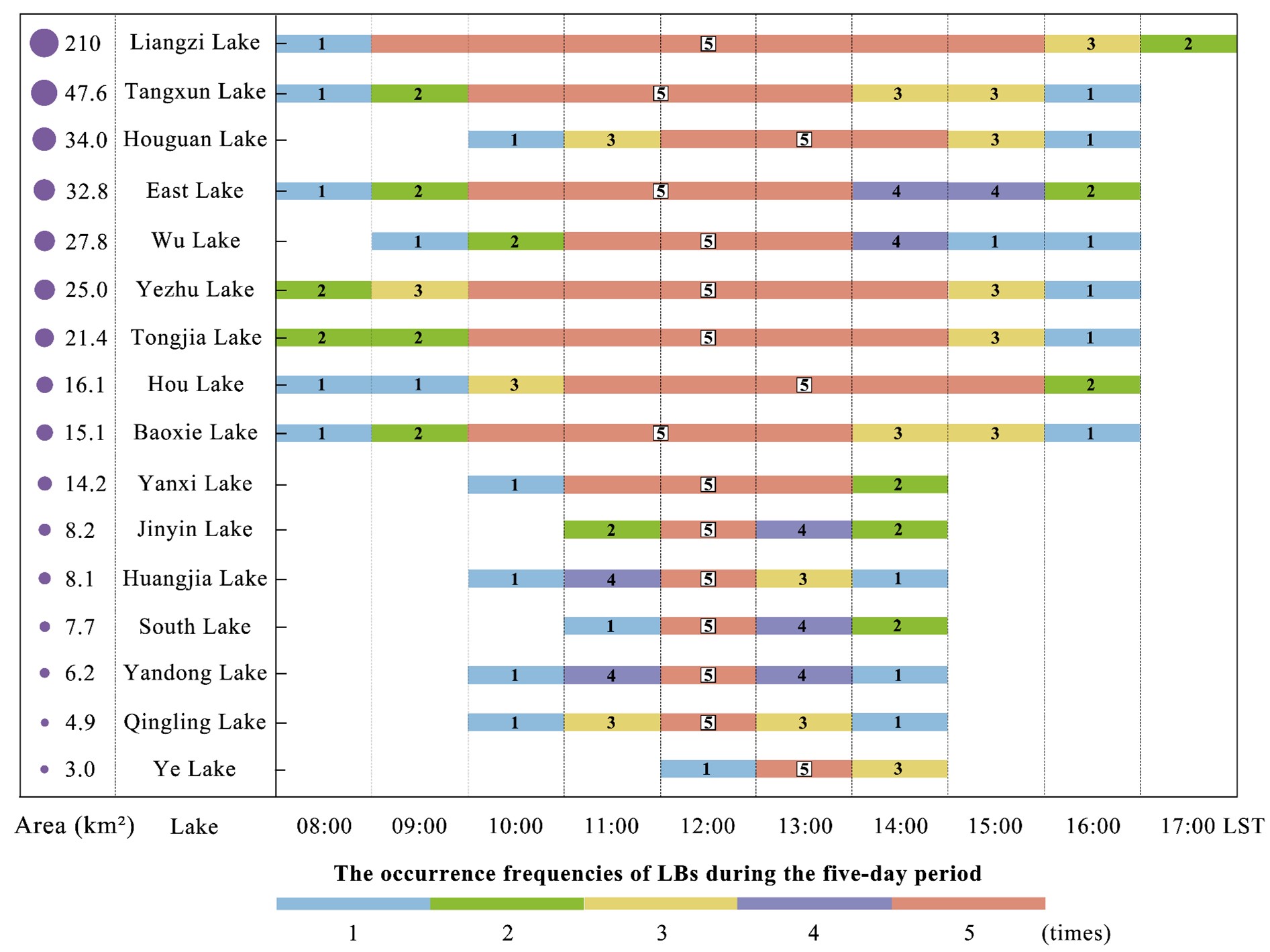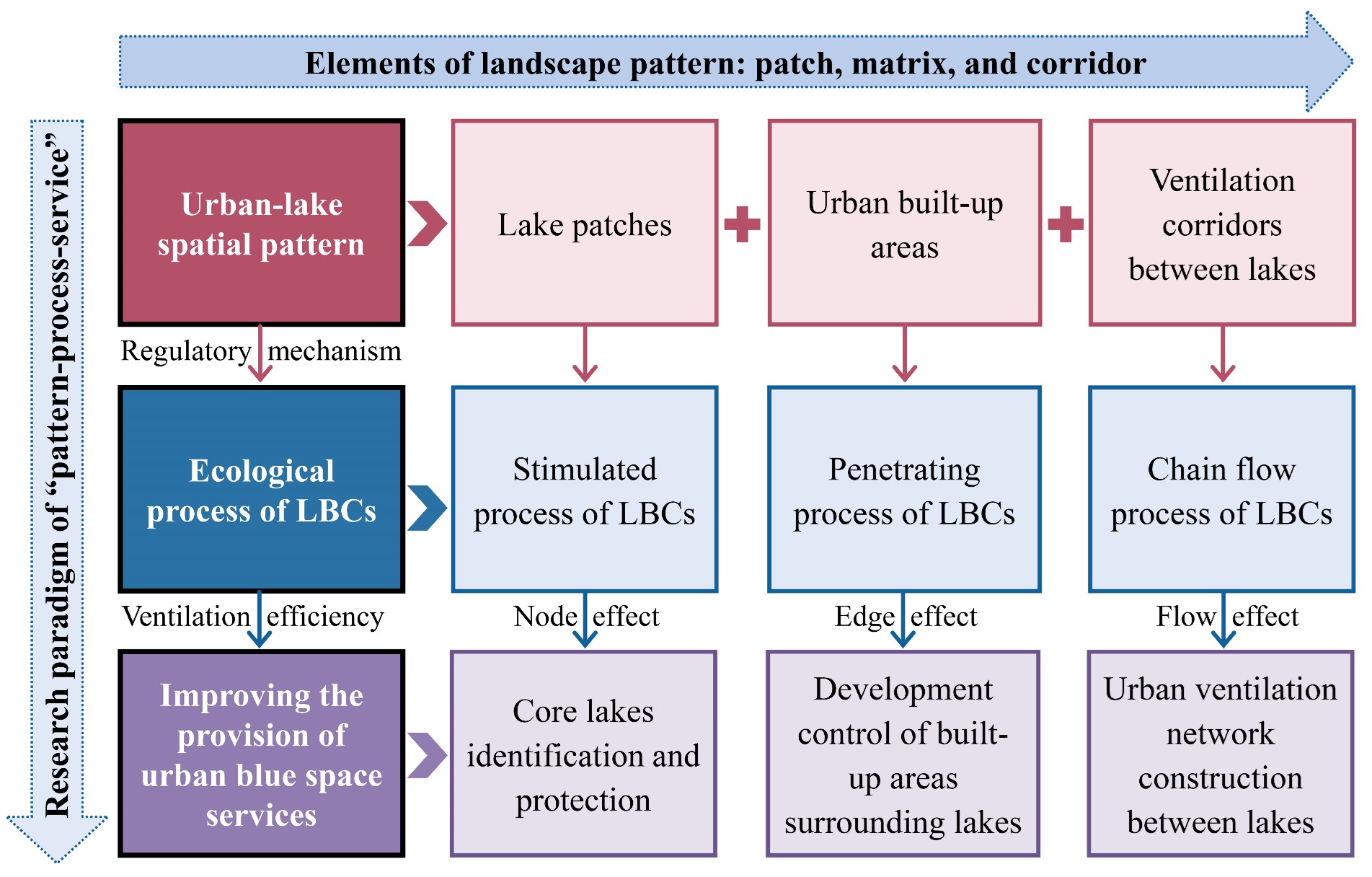南湖新闻网讯(通讯员 成雅田)近日,我校园艺林学学院城市生态健康诊断与蓝绿空间效能优化创新团队吴昌广副教授课题组在基于自然解决方案的气候适应性城市规划方面取得新进展,研究成果以“How to use lake breeze circulations to improve urban natural ventilation: A case study in a typical inland multi-lake megacity”为题在城市研究类国际学术期刊Landscape and Urban Planning上发表。
利用城市地区自然湖泊促进市区内部通风环境,是内陆城市应对高温冲击、提升气候韧性的基于自然的解决方案。揭示大都市区中小型湖泊所激发的湖风环流结构、过程及其维持机制,是科学利用湖风提升城市呼吸性能的理论基础。针对这一科学问题,研究团队利用高精度下垫面土地利用类型数据和耦合单层城市冠层模型(UCM)的WRF模式,对2018年夏季静稳天气下武汉都市发展区的近地面气象场进行模拟,探讨不同湖泊的湖风生成发展过程、环流结构特征以及多个湖泊间的湖风环流耦合效应。研究发现:局地湖风总体呈现上午开始形成、午后发展旺盛、日落前后逐渐消散的规律,但湖风持续时间会受湖泊区位、规模、形状等显著影响;上、下风岸湖风环流结构存在差异,下风岸的羽流结构相比上风岸的环流结构更易增强湖风向周边建成区的渗透距离;沿主导风向分布的多个湖泊间易形成湖风环流链式流动,促进湖泊上空冷气与更大范围建成区的空气交换。根据研究结果,团队总结了夏季典型湖风日不同湖泊形成的湖风环流在都市区内的流动规律,基于“斑块-廊道-基质”景观三要素在空间规划层面提出了有利于湖风环流触发、维持、渗透的城市自然通风格局构建框架与规划策略。

图1 夏季高温弱风天气下武汉都市发展区不同区位、规模、形状的湖泊湖风发生频率

图2 夏季典型湖风日武汉都市发展区沿垂直于主导风向分布的湖泊湖风环流垂直结构特征

图3 夏季典型湖风日不同区位湖泊湖风环流垂直结构模式图

图4 利用湖风环流构建城市自然通风格局的概念框架

图5 利用湖风环流促进城市自然通风的规划路径与策略
园艺林学学院博士研究生成雅田为论文第一作者,吴昌广副教授为论文通讯作者,我校滕明君副教授、张斌教授、中科院沈阳应用生态研究所沈历都博士、武汉公共气象服务中心刘火胜高级工程师、武汉市林业工作站程维金站长参与了研究工作。该研究得到了国家自然科学基金面上项目、中央高校基本科研业务费和武汉市园林林业局科技计划资助。
审核人:吴昌广
【英文摘要】
Utilizing lake breeze circulations (LBCs) to improve city breathability is one of the most promising nature-based solutions for inland cities under calm and stable weather conditions. Previous studies highlighted the LBC benefits from great-sized lakes to mitigate urban heat island effects at the regional scale. How cold air flows out from relatively small lakes to influence the heat transfer process within urban areas, however, remains unclear. Using the Weather Research and Forecasting (WRF) model, the temporal development of lake breezes (LBs) was simulated in Wuhan city on hot days with weak synoptic wind. We further explored the spatial structures of a single LBC and the interactions of multiple LBCs on a typical LB day. The results indicate that LBs occurred mostly in the morning, peaked around noon, and dissipated in the afternoon. The LB occurrence periods with high probability varied significantly with the lake size, shape, location, and distribution. Specifically, large lakes with simple shapes and aggregated distribution were more likely to develop and sustain LBs. There were distinct LBC flow regimes on different lakeshores, in which the perturbed LBC mainly on leeward lakeshores increased cool air penetrability compared with the strong LBC predominantly on windward lakeshores. In addition, chain flows of LBCs formed over lake groups parallel to the prevailing synoptic wind, as the upper-level outflows from one upwind LBC were connected to the lower-level inflows from the other downwind LBC. Based on these results, we propose a conceptual framework for planning urban blue space to enhance natural ventilation, which can support urban planners to create livable built environments with lake breezes entry.
论文链接:https://linkinghub.elsevier.com/retrieve/pii/S0169204622002778






